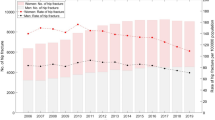Abstract:
After several reports of increasing hip fracture incidence some studies have suggested a trend-break. In a previous study of hip fractures we forecast a 70% increase in the total number of fractures from 1985 up to year 2000. We therefore studied the incidence trend for the last 15 years and supply a new prognosis up to year 2010. We recorded all incident hip fractures treated in the county of Östergötland, Sweden (≈ 400 000 inhabitants) 1982–96. A total of 11 517 hip fractures in men and women aged 50 years and above were included in the study after cross-validation between a computerized register of radiologic investigations and the hospital records. The projected number of fractures up to year 2010 was estimated by a Poisson regression model, considering both age and year of fracture in every single year 1982–96 for the respective fracture type and gender, and applied to the projected population. The annual number of hip fractures increased by 39% in men and 25% in women during the study period. Amongst men, the age-adjusted incidence of cervical fractures increased from 188 to 220/100 000 and of trochanteric fractures from 138 to 170/100 000. In women the incidence of cervical fractures decreased from 462/100 000 to 418/100 000 and of trochanteric fractures from 407/100 000 to 361/100 000. Cervical/trochanteric fracture incidence rate ratio leveled off, and also the female/male fracture rate ratio declined. A prognosis assuming that the incidence development will continue as during 1982–96, and a population in agreement with the forecast, predicts that the total age- and sex-adjusted number of hip fractures will decrease by 11% up to year 2010 compared with 1996. In women and men, however, a decrease of 19% and an increase of 7% respectively were projected. If the age- and sex-specific incidence remains at the same level as at the end of the study period, no significant change in the total numbers will occur. A trend-break was thus found in hip fracture incidence for women but not for men. Whether this is due to therapeutic and/or preventive measures in women is unknown. According to the most probable scenario a substantial increase in male trochanteric fractures (36%) is expected up to 2010, while all other hip fractures in both genders will decrease by 4–32% resulting in a total reduction of 11%.
Similar content being viewed by others
Author information
Authors and Affiliations
Additional information
Received: 17 November 2000 / Accepted: 2 July 2001
Rights and permissions
About this article
Cite this article
Löfman, O., Berglund, K., Larsson, L. et al. Changes in Hip Fracture Epidemiology: Redistribution Between Ages, Genders and Fracture Types. Osteoporos Int 13, 18–25 (2002). https://doi.org/10.1007/s198-002-8333-x
Issue Date:
DOI: https://doi.org/10.1007/s198-002-8333-x




